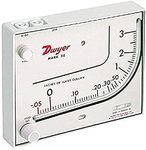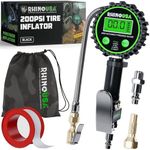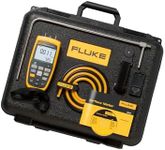Buying Guide for the Best Manometers
Choosing the right manometer, a device used to measure pressure, is crucial for ensuring accurate readings and optimal performance in various applications. Whether you're using it for industrial purposes, HVAC systems, or laboratory experiments, understanding the key specifications will help you select the best manometer for your needs. Here are the essential specs to consider and how to navigate them.Pressure RangeThe pressure range indicates the minimum and maximum pressure that the manometer can measure. This is important because using a manometer outside its specified range can lead to inaccurate readings or damage to the device. Pressure ranges are typically divided into low, medium, and high. Low-pressure manometers are suitable for applications like HVAC systems, medium-pressure ones are often used in industrial settings, and high-pressure manometers are used in more demanding environments like hydraulic systems. Choose a manometer with a pressure range that matches or slightly exceeds the maximum pressure you expect to measure.
AccuracyAccuracy refers to how close the manometer's readings are to the actual pressure. This is crucial for applications where precise measurements are necessary. Accuracy is usually expressed as a percentage of the full-scale reading. For example, a manometer with an accuracy of ±1% of full scale will have a smaller margin of error than one with ±2%. Higher accuracy is essential for laboratory and calibration purposes, while lower accuracy may be acceptable for general industrial use. Determine the level of precision required for your application to choose the appropriate accuracy.
ResolutionResolution is the smallest change in pressure that the manometer can detect. This is important for applications that require detecting minute changes in pressure. Higher resolution manometers can detect smaller changes, making them suitable for detailed analysis and fine-tuning processes. Lower resolution manometers are adequate for general monitoring where small changes are not critical. Consider the level of detail you need in your pressure measurements to select the right resolution.
Type of ManometerThere are several types of manometers, including digital, analog, and liquid column manometers. Digital manometers provide easy-to-read displays and often come with additional features like data logging. Analog manometers are simple and reliable, often used in rugged environments. Liquid column manometers, such as U-tube manometers, are highly accurate but can be more challenging to read and handle. Choose the type that best fits your application and user preference. For instance, digital manometers are great for quick and easy readings, while liquid column manometers are ideal for high-precision tasks.
Durability and Build QualityDurability and build quality determine how well the manometer can withstand the conditions of its intended use. This is important for ensuring longevity and reliability. Manometers used in harsh environments should be made of robust materials like stainless steel or reinforced plastics. For laboratory use, where conditions are controlled, build quality may be less of a concern. Assess the environment in which the manometer will be used and choose one with the appropriate durability and build quality to ensure it can handle the conditions.
Additional FeaturesAdditional features can enhance the functionality and ease of use of a manometer. These may include backlit displays for low-light conditions, data logging capabilities for tracking pressure over time, and connectivity options like Bluetooth or USB for transferring data to other devices. While these features are not essential, they can provide added convenience and efficiency. Consider which additional features would be beneficial for your specific application and choose a manometer that offers those enhancements.















